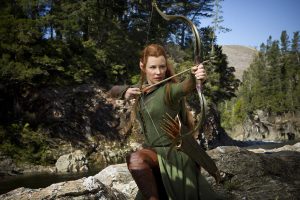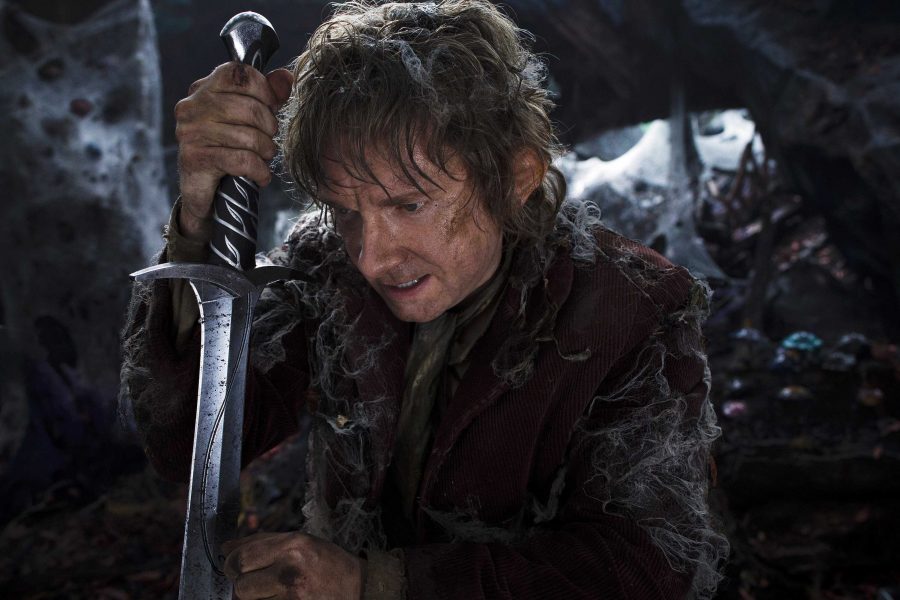
When I found out a few years ago that director Peter Jackson would be transforming one of my favorite novels, “The Hobbit” by J. R. R. Tolkien, into a film, I was overjoyed. When I found out he was going to stretch that novel into three separate films, I was worried. Now, after watching “The Hobbit: The Desolation of Smaug,” I’m impressed.
In this continuation of Jackson’s epic fantasy trilogy, released Dec. 13, Bilbo’s journey with Thorin and his fellow dwarves to seek a famed diamond, the Arkenstone, the symbol of the King under the Mountain, which Thorin can use to unite the dwarf clans against the evil dragon Smaug. Along the way, they encounter a skin changer, elves, orcs, and the poverty-stricken humans of Lake-town before finally entering the Lonely Mountain and confronting the dragon.
Martin Freeman continues to shine as disgruntled hobbit Bilbo Baggins, broadcasting the hobbit’s “200% done with this dwarf nonsense” attitude perfectly while still projecting hope in the darkest of times. Another standout character is the elf king Thranduil (portrayed by Lee Pace from “Pushing Daisies”), who perfectly captures the cold beauty and dark side of the elves, offering a brilliant foil for the elven character Tauriel, who is a butt-kicking beacon of compassion.
The cinematography of the film, which was filmed in the sweeping splendor of New Zealand, is breathtaking. Throughout the film, the tones of each shot shift to fit the current mood, resulting in cold, silvery shots in the darkness of the forest of Mirkwood and rich, colorful panoramas as Thorin and company travel across the wide plains of Middle Earth.
As a fan of Tolkien’s works, my favorite part of the movie experience was seeing the places that I’d read about come to life. Words can hardly describe the splendor of the treasure trove within the Lonely Mountain, and the elegant, organic designs of the elven stronghold within Mirkwood were incredible. Even the humble home of Beorn, which the group stops at to rest for the night, is presented with stunning attention to detail.
In addition to these landscapes, many of which were comprised of mainly CGI elements, the characters themselves appear otherworldly. There are times when the CGI looks a bit off, almost like a shot from a video game (enter Legolas leaping across the heads of the dwarves like stepping stones), but other elements, like the dragon Smaug (voiced by Freeman’s “Sherlock” costar, Benedict Cumberbatch), are flawlessly executed.
The spiders that the group encounter in Mirkwood are also impressive, and are major improvements on the spider Shelhob from “The Lord of the Rings,” clearly taking advantage of improved CGI techniques.
I went in to the film slightly worried about creative liberties taken by Jackson and other screenplay writers Fran Walsh, Philippa Boyens, and Guillermo del Toro, but the additional elements and backstories that were added to the plot flowed seamlessly with the novel itself, as well as with Tolkien’s later works like “The Lord of the Rings” trilogy and “The Silmarillion.”
Specifically, the addition of the original female elf character Tauriel (portrayed by Evangeline Lilly of “Lost” fame) adds a much needed female character to a mainly male cast of characters. Lilly portrays Tauriel as a warrior, harkening back to the character Eowyn from “The Lord of the Rings: The Two Towers.” Though she’s not a character in the original work, she perfectly captures all of the best qualities of the elves, and demonstrates that women have as much right to be the heroes of fantasy films as men do.
Though the film did end with a cliffhanger, it isn’t too suspenseful, and still leaves you eager to see the third film of the trilogy, which is due to be released Dec. 17 of next year. Overall, though a few CGI scenes were a bit cringe-worthy and character interaction could be a bit cheesy, I truly enjoyed this modern rendition of J. R. R. Tolkien’s classic story, which deserves five out of five stars.

